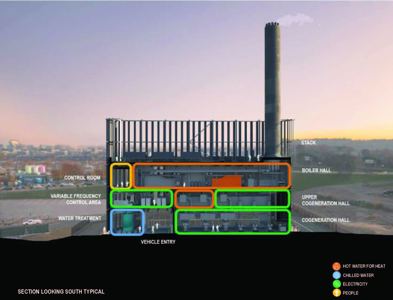

Harvard University District Energy Facility
Leers Weinzapfel Associates
The District Energy Facility (DEF) client brief required a state-of-the-art, cost effective, resilient, and sustainable energy generation system for Harvard University’s Allston campus. Resiliency, flexibility, and innovation were key goals for the design to transition to a fossil-fuel-free future, withstand climate impacts including storm surge flooding, and provide a reliable source of heating, cooling, and electricity on the campus. On a small site in a deserted railyard, the DEF will soon be surrounded by science and engineering development, conference/hotel, and midrise residences. The building’s compact cubic form maximizes area for future development around it while maintaining a singular bold and refined presence. Rounded corners facilitate vehicle turning on the tight site. Petal-like anodized-aluminum fins form a wrapper around the building, revealing, or concealing the various equipment areas, while showing technology on display. The project is a visual celebration of the numerous invisible benefits of district energy plants: resiliency, energy efficiency, reduced energy costs, decreased carbon emissions, lowered air pollution, and minimized acoustical transmission.
In addition to the many benefits of a district energy facility, the construction of the DEF is an opportunity to contribute to infrastructure design in the urban and campus form. Centrally located to serve multiple buildings in the district, the DEF faces the pressures of relating in scale to future and nearby structures, while mitigating noise and air quality. An innovative approach is required to celebrate these facilities’ energy and robust beauty and make them good neighbors. Building completion and acceptance was January 4, 2021.